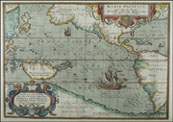|
Place Names on Antique Maps
One of the fascinating things about antique maps are the variety of place names that are found. This sometimes makes it confusing to figure out exactly what location or locations is on a particular map. You'll encounter this when looking at many of the maps on this site.
There are lots of reasons for this wide variety of names, and some of these are discussed on this page.
- Language differences. The simplest source of place name differences (today and in the past) is the result of the names used in different languages for the same place. These can be simple translations (d'Etats Unie in French for the United States) or the result of historically different names for the same place (Germany in English for Deutschland). Antique mapmakers usually used their own languages to name places; so maps of the same location drawn by Dutch and French mapmakers will use different names. Sometimes, you'll find the identical map with a completely different set of names.
- Political differences. Sometimes these name differences aren't simple language differences, but include significant political implications. Names can carry implications about ownership and control (such as the names of the Persian Gulf and Arabian Gulf for the same body of water). This was particularly true during the era of western exploration. For example, using the name "Sandwich Islands" would acknowledge British control that the name "Hawaiian Islands" didn't.
- Historical name changes. Over time, place names change, so when you look at maps from past eras (or even just a few years ago!), you need to keep this in mind.
- Transcription errors. Western explorers varied greatly in the manner in which they dealt with native residents of the lands they were exploring. This often shows up in place names; some explorers tried to learn and use native names for places, while others were not as interested. But since many of these peoples had no written language, it was not unusual to find a variety of interpretations of a particular name (for example, Owyhee and Hawaii).
- Vague and inaccurate geography. The Pacific Ocean is a large area, and the poor techology of the era (especially in computing longitude) made it easy for explorers to make mistakes when noting the locations of specific islands. It was not unusual for an explorer to discover an island that was already known by a different name, simply for this reason. It could take decades to straighten this out.
- Island grouping. An issue somewhat unique to the Pacific has to do with the naming of island groups. There are literally thousands of islands around the Pacific, so they are usually grouped for convenience based on historical, geographical, and political bases. But this led to confusion, especially in the western Pacific where island groups are numerous and located close together. It was easy for people to confuse names and groups, and to use one name for another group. For example, the term "Moluccas" typically referred to a small group of islands in eastern Indonesia, but was occasionally (and erroneously) used to refer to the Marianas Islands.
|
